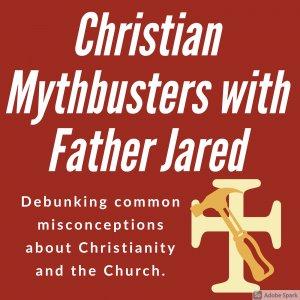Christian Mythbusters

Myths of Why Jesus Died, Part Two (or Why I prefer Christus Victor)
This is Father Jared Cramer from St. John’s Episcopal Church in Grand Haven, Michigan, here with today’s edition of Christian Mythbusters, a regular segment I offer to counter some common misconceptions about the Christian faith.
In my last episode we were in the midst of Holy Week and I talked about all the various ways we can understand the meaning of what Christians believe Christ did on the cross, something called the theory of the atonement. I talked about what’s known as the “satisfaction” theory of the atonement, and suggested that rather than believing that Jesus died to satisfy the wrath of an angry God, we should instead see that theory as God in Christ choosing to suffer alongside of us, to make right in God’s own being the horrors and injustices humanity has wrought.
I also promised that I’d share some other ways Christians can understand what Christ did on the cross. So, this week, I’m going to continue my work breaking the myth that Jesus died so you can go to heaven because, as I said last time, it’s about so much more than that.
In 1931 a Lutheran bishop and theologian named Gustaf Aulén published a book titled Christus Victor which set out the three historical theories of the atonement. One of those is the “satisfaction” theory that I talked about last week. But neither Aulén (nor many theologians since then) have believed that the “satisfaction” theory is the best explanation (it’s certainly not the only explanation), particularly given the witness of Scripture and the early church.
Instead, Aulén encouraged a recovery of what he called the “classic” view of the atonement, the one that was dominant in the early church. That view is the Christus Victor understanding of the atonement (hence the title of the book).
He characterized this view as follows: “Its central theme is the idea of the Atonement as a Divine conflict and victory; Christ – Christus Victor – fights against and triumphs over the evil powers of the world, the 'tyrants' under which humanity is in bondage and suffering, and in Him God reconciles the world to Himself.”
I love the way this view is articulated in the Paschal Homily, a sermon written in the late fourth century by John Chrysostom. It’s a tradition in Orthodoxy to preach this homily at the Great Vigil of Easter on Saturday night before Sunday each year, and my own parish keeps the tradition as well.
In the sermon, Chrysostom writes, “Let no one fear death, for the death of our Savior has set us free. He has destroyed it by enduring it. He destroyed Hades when he descended into it.
He put it into an uproar even as it tasted of His flesh… Hell is in an uproar because it is now made captive. Hell took a body, and it discovered God. It took earth, and encountered Heaven. It took what it saw, and was overcome by what it did not see.”
This theory has been particularly potent among Liberation theologians because it sees salvation as the rescue of humanity from the powers of this world. And given the state of the world today, and the struggles of minorities and marginalized communities, I think the idea of divine rescue is one I can get behind… particularly because it also makes clear that Christ triumphed over death, hatred, and the powers of this world and so those who follow him must walk the same path and undo injustice and the power of evil in our own time until every person is set free.
Thanks for being with me. To find out more about my parish, you can go to sjegh.com. Until next time, remember, protest like Jesus, love recklessly, and live your faith out in a community that accepts you but also challenges you to be better tomorrow than you are today.






 Visit Podcast Website
Visit Podcast Website RSS Podcast Feed
RSS Podcast Feed Subscribe
Subscribe
 Add to MyCast
Add to MyCast